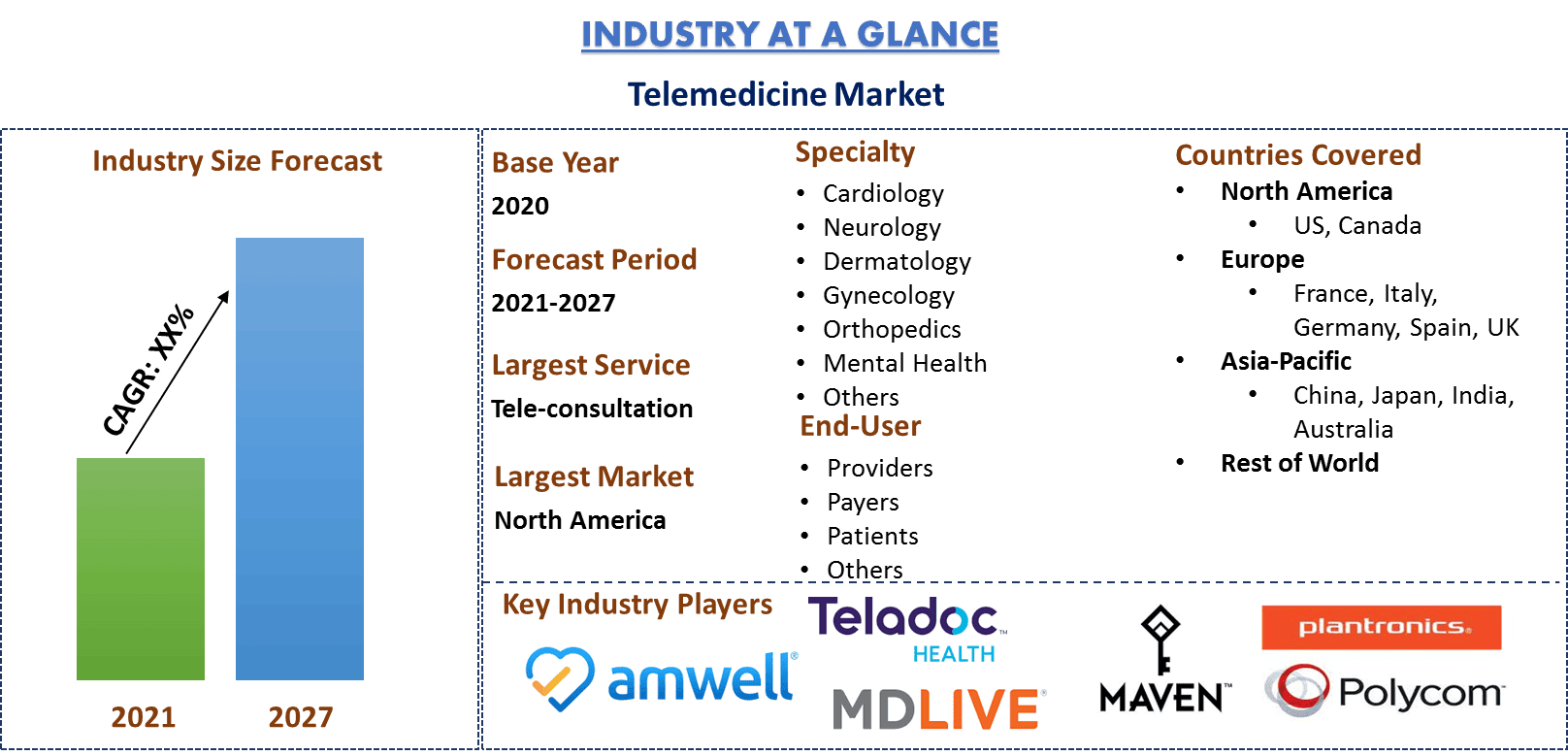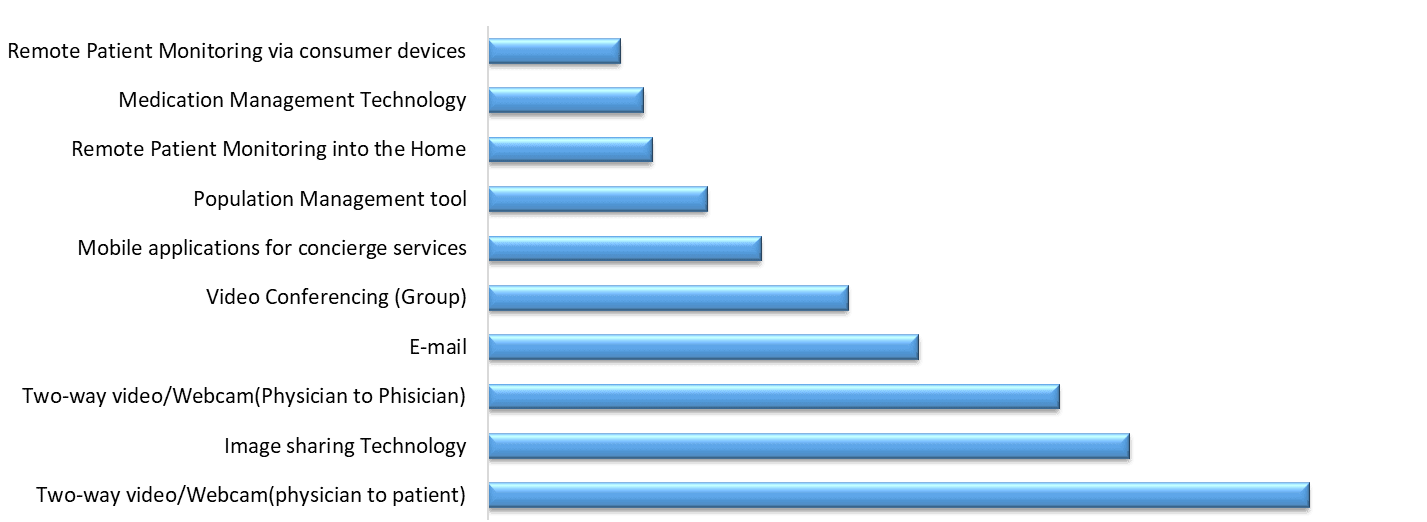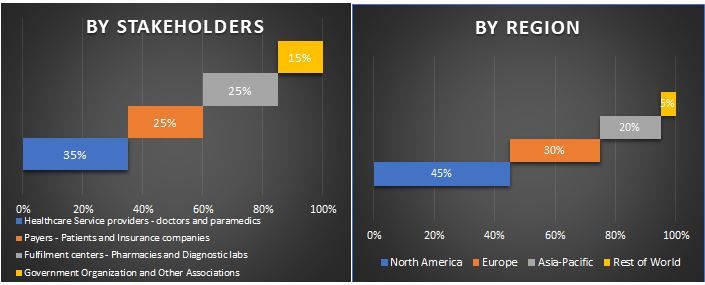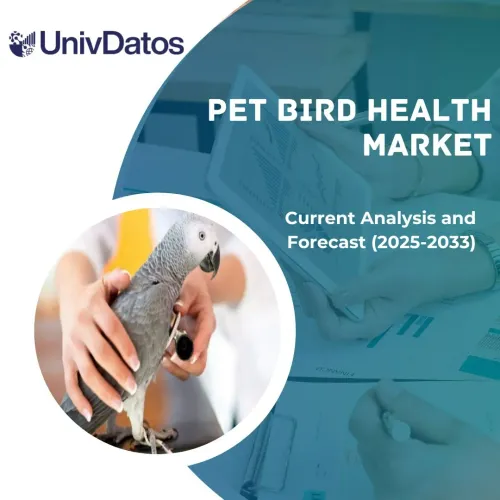- Home
- About Us
- Industry
- Services
- Reading
- Contact Us
Telemedicine Market: Current Analysis and Forecast (2021-2027)
Emphasis on Service (Tele-Consulting, Tele-Monitoring, Tele-Education); Specialty (Cardiology, Neurology, Dermatology, Gynecology, Orthopedics, Mental Health, Others); Delivery Mode (Web/Mobile, Call Canters); Modality (Real-time, Store, Forward and others), End-Users (Providers, Payers, Patients, Others), and Region & Country

Telemedicine is termed as process of distributing healthcare services virtually. In the digital world Telemedicine is considered to the most adaptable technology available that helps accessing health education, health information and health care at a distance. Other advancements in the category includes patient-centric care and increased admittance to remote locations. It not only benefits patients to connect to doctors or hospitals remotely but it also diminishes the cost in healthcare. For instance, Patients in rural areas have inadequate access to medical professionals; on average, only 40 specialists are serving 100,000 rural population, globally. Emerging adoption of telemedicine across end-users’ is helping in the market growth. According to Massachusetts General Hospital, 79% of patients stated that scheduling a telemedicine follow-up visit was easier and more suitable than arranging an in-person follow-up. Moreover, the hospitals are emerging and have begun implementing telemedicine in their practice. According to the annual survey of the American Hospital Association (AHA), in 2019, the Use of telehealth in hospitals has grown significantly from 35% in 2010 to 76% in 2018. Also, implementation of remote patient monitoring capabilities at hospitals has grown from 43.1% in 2015 to 61.2% in 2017. Virtual care technology saves patients time and money, by reducing patient transfers, emergency department and urgent care center visits, and delivers savings to payers. Besides this, telemedicine helps to address physician exhaustion by decreasing clinician’s drive times and permitting more time for patients. Telemedicine allows Remote patient monitoring and live videoconferencing facility between patient and doctors. According to the Vidyo Telehealth Adoption Survey 2019, 46% of surveyed health care providers (hospitals and clinics) use live videoconferencing, and 41% used RPM to deliver medical care.
Telehealth services provided by hospitals, 2019 (%)

Insights Presented in the Report
“Amongst Service, Tele-consultation service holds the largest market share in 2020.”
Based on Service, the market is fragmented into Tele-consulting, Tele-monitoring, and Tele-education. It is anticipated that Tele-consultation service would maintain its dominance owing to telemedicine applications that support health provider’s stay connected with their patients are more appreciated and appropriate than they have ever been.
“Amongst Specialty, Mental health is anticipated to grow at the highest CAGR during the analyzed period”
Based on specialty, the market is fragmented into Cardiology, Neurology, Dermatology, Gynecology, Orthopedics, Mental health, and Others. In 2020, the Mental health or Telepsychiatry segment accounted for a maximum market revenue by adding 21% to previous year revenue.
“Amongst Delivery mode, Mobile/Web is anticipated to grow at the highest CAGR during the analyzed period”
Based on Delivery mode, the market is fragmented into Mobile/Web and Call centers. The Web/Mobile segment accounted for the major revenue share, accounting for 75.2% share in 2020. The segment is anticipated to observe significant growth in the upcoming years through offering direct admittance to care delivery solutions.
“Amongst Modality, Real-time segment holds the major share”
Based on Modality, the market is fragmented into Real-time, Store and Forward, and others. The real-time segment is anticipated to observe profitable growth due to the extreme rise in the number of virtual visits. According to the On-demand Virtual Care Benchmark Survey, 32.1% of doctors in the US had an on-demand virtual care service in 2018. This is expected to boost the substantial growth of the real-time segment.
“Amongst end-user, the Provider’s Segment holds the major share in 2020.”
Based on end-user, the market is fragmented into Providers, Payers, Patients, and Others. The Providers segment is anticipated to observe lucrative growth of more than 41.2% due to the extreme rise in the number of virtual visits.
“North America signifies one of the largest markets of Telemedicine Market”
For a better understanding of the market adoption of telemedicine, detailed regional level analysis id done for major regions including North America (US, Canada, and Rest of North America), Europe (Germany, UK, France, Italy, Spain, and Rest of Europe), Asia-Pacific (China, Japan, India, Australia, and Rest of APAC), and Rest of World. North America dominates the market, owing to chaotic schedules, busy and fast lifestyle, and increasing awareness about the benefit of telemedicine technology.
Competitive Landscape:
Some of the major players operating in the market include MDlive, Inc., SteadyMD, Inc., Maven, Inc., HealthTap, Inc., BioTelemetry, Inc., American Well, CVS Health, Teladoc Health, Inc., Doctor on Demand, Inc, Plantronics, Inc. (Polycom), etc. Several M&As along with Partnerships have been undertaken by these players to boost their presence in different regions.
Reasons to buy this report:
- The study includes market sizing and forecasting analysis validated by authenticated key industry experts
- The report presents a quick review of overall industry performance at one glance
- The report covers an in-depth analysis of prominent industry peers with a primary focus on key business financials, product portfolio, expansion strategies, and recent developments
- Detailed examination of drivers, restraints, key trends, and opportunities prevailing in the industry
- The study comprehensively covers the market across different segments
- Deep dive regional level analysis of the industry
Customization Options:
The Telemedicine Market can further be customized as per the requirement or any other market segment. Besides this, UMI understands that you may have your own business needs, hence feel free to connect with us to get a report that completely suits your requirements.
Table of Content
Analyzing the historical market, estimation of the current market, and forecasting the future market of the Global telemedicine Market were the three major steps undertaken to create and analyze the adoption of telemedicine for patient comfort across major regions globally. Exhaustive secondary research was conducted to collect the historical market numbers and estimate the current market size. Secondly, to validate these insights, numerous findings and assumptions were taken into consideration. Moreover, exhaustive primary interviews were also conducted, with industry experts across the value chain of the Telemedicine sector. Post assumption and validation of market numbers through primary interviews, we employed a bottom-up approach to forecast the complete market size. Thereafter, market breakdown and data triangulation methods were adopted to estimate and analyze the market size of major segments and sub-segments the industry pertains to. Detailed methodology is explained below:
Analysis of Historical Market Size
Step 1: In-Depth Study of Secondary Sources:
Detailed secondary study was conducted to obtain the historical market size of the telemedicine through company internal sources such as annual report & financial statements, performance presentations, press releases, etc., and external sources including journals, news & articles, government publications, competitor publications, sector reports, third-party database, and other credible publications.
Step 2: Market Segmentation:
After obtaining the historical market size of the telemedicine market, we conducted a detailed secondary analysis to gather historical market insights and share for different segments for major regions. Major segments included in the report are Service, Specialty, Delivery mode, Modality, and End-user. Further country-level analyses were conducted to evaluate the overall adoption of telemedicine technology across major regions.
Step 3: Factor Analysis:
After acquiring the historical market size of different segments and sub-segments, we conducted a detailed factor analysis to estimate the current market size of telemedicine service. Further, we conducted factor analysis using dependent and independent variables such as rising adoption of virtual care service, increasing investments in telehealth and telemedicine sector, and growing elderly population etc. A thorough analysis was conducted for demand and supply-side scenarios considering top partnerships, merger and acquisition, business expansion, and product launches in the telemedicine industry across the globe.
Current Market Size Estimate & Forecast
Current Market Sizing: Based on actionable insights from the above 3 steps, we arrived at the current market size, key players, and market shares of the different segments and sub-segments. All the required percentage shares split, and market breakdowns were determined using the above-mentioned secondary approach and were verified through primary interviews.
Estimation & Forecasting: For market estimation and forecast, weights were assigned to different factors including drivers & trends, restraints, and opportunities available for the stakeholders. After analyzing these factors, relevant forecasting techniques i.e., bottom-up approach was applied to arrive at the market forecast to 2027 for different segments and subsegments. The research methodology adopted to estimate the market size encompasses:
- The industry’s market size, in terms of value (US$) and the adoption rate of telemedicine service across major markets domestically
- All percentage shares, splits, and breakdowns of market segments and sub-segments
- Key players in the telemedicine market in terms of services offered. Also, the growth strategies adopted by these players to compete in the fast-growing market
Market Size and Share Validation
Primary Research: In-depth interviews were conducted with the Key Opinion Leaders (KOLs) including Top Level Executives (CXO/VPs, Sales Head, Marketing Head, Operational Head, and Regional Head, Country Head, etc.) across major regions. Primary research findings were then summarized, and statistical analysis was performed to prove the stated hypothesis. Inputs from primary research were consolidated with secondary findings, hence turning information into actionable insights.
Split of Primary Participants in Different Regions
Market Engineering
Data triangulation technique was employed to complete the overall market estimation and to arrive at precise statistical numbers of each segment and sub-segment of the telemedicine market pertains to. Data was split into several segments & sub-segments post studying various parameters and trends in the areas of Service, Specialty, Delivery mode, Modality, and End-user.
Main Objective of the Telemedicine Market Study
The current & future market trends of telemedicine service were pinpointed in the study. Investors can gain strategic insights to base their discretion for investments from the qualitative and quantitative analysis performed in the study. Current and future market trends were determined the overall attractiveness of the market at a regional level, providing a platform for the industrial participant to exploit the untapped market to benefit as a first-mover advantage. Other quantitative goals of the studies include:
- Analyze the current and forecast market size of telemedicine service in terms of value (US$). Also, analyze the current and forecast market size of different segments and sub-segments
- Segments in the study include areas of Service, Specialty, Delivery mode, Modality, and End-user
- Define and analysis of the regulatory framework for the telemedicine industry
- Analyze the value chain involved with the presence of various intermediaries, along with analyzing customer and competitor behaviors of the industry
- Analyze the current and forecast market size of the telemedicine market for the major region including North America (US, Canada, Rest of North America), Europe (Germany, UK, France, Italy, Spain, Rest of Europe), Asia-Pacific (China, Japan, India, Australia, Rest of APAC), and Rest of the World
- Company profiles of the telemedicine market and the growth strategies adopted by the market players to sustain in the fast-growing market
- Deep dive country level analysis of the industry
Related Reports
Customers who bought this item also bought











